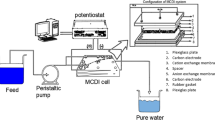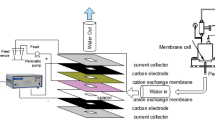Abstract
Nitrate is among the important types of pollutant sources in drinking water worldwide, and there are a number of methods to remove it from water. New treatment methods are being developed as an alternative to traditional treatment methods. One of them is membrane capacitive deionization (MCDI). In this study, the removal of nitrate ions with MCDI system was investigated. Nitrate solutions were treated via MCDI at different operating conditions. The obtained nitrate removal efficiency reached 83.07% at a flow rate of 2.5 L/min and a potential of 0.8 V was applied. In addition, during the nitrate removal of the MCDI system, the environmental effects were evaluated by life cycle analysis. As a result of these analyses, MCDI system offered advantages of low energy demand and low-energy environmental effects during operation. The results showed that the improved MCDI technology holds a great potential to be an energy-efficient process for nitrate removal. Life cycle assessment was applied to the experimental study. According to the assessment, water consumption had the highest effect in all damage assessment categories.



Similar content being viewed by others
References
Bilgili, L., Kuzu, S. L., Çetinkaya, A. Y., & Kumar, P. (2019). Evaluation of railway versus highway emissions using LCA approach between the two cities of Middle Anatolia. Sustainable Cities and Society, 49, 101635.
Britto, A. L., Maiello, A., & Quintslr, S. (2019). Water supply system in the Rio de Janeiro Metropolitan Region: Open issues, contradictions, and challenges for water access in an emerging megacity. Journal of Hydrology, 573, 1007–1020.
Cetinkaya, A. Y. (2019). Effect of operating parameters on boron removal using a combined system. Materials Research Express, 6(7), 075509.
Cetinkaya, A. Y., & Bilgili, L. (2019). Life cycle comparison of membrane capacitive deionization and reverse osmosis membrane for textile wastewater treatment. Water, Air, & Soil Pollution, 230(7), 149.
Çetinkaya, A. Y., Bilgili, L., & Kuzu, S. L. (2018). Life cycle assessment and greenhouse gas emission evaluation from Aksaray solid waste disposal facility. Air Quality, Atmosphere and Health, 11(5), 549–558.
Choi, J., Dorji, P., Shon, H. K., & Hong, S. (2019a). Applications of capacitive deionization: Desalination, softening, selective removal, and energy efficiency. Desalination, 449, 118–130.
Choi, J., Oh, Y., Chae, S., & Hong, S. (2019b). Membrane capacitive deionization-reverse electrodialysis hybrid system for improving energy efficiency of reverse osmosis seawater desalination. Desalination, 462, 19–28.
Damkjaer, S., & Taylor, R. (2017). The measurement of water scarcity: Defining a meaningful indicator. Ambio, 46(5), 513–531.
Dorji, P., Choi, J., Kim, D. I., Phuntsho, S., Hong, S., & Shon, H. K. (2018). Membrane capacitive deionisation as an alternative to the 2nd pass for seawater reverse osmosis desalination plant for bromide removal. Desalination, 433, 113–119.
Goedkoop, M. J., Heijungs, R., Huijbregts, M. A. J., De Schryver, A., Struijs, J., van Zelm, R., & ReCiPe. (2008). A life cycle impact assessment method which comprises harmonised category indicators at the midpoint and the endpoint level. https://doi.org/10.2307/40184439.
Hanjra, M. A., & Qureshi, M. E. (2010). Global water crisis and future food security in an era of climate change. Food Policy, 35(5), 365–377.
Huijbregts, M., Steinmann, Z. J. N., Elshout, P. M. F. M., Stam, G., Verones, F., Vieira, M. D. M., & ReCiPe. (2016, 2016). A harmonized life cycle impact assessment method at midpoint and endpoint level: Report I-Characterization., 22, 138–147. https://doi.org/10.1007/s11367-016-1246-y.
Jain, A., Weathers, C., Kim, J., Meyer, M. D., Walker, W. S., Li, Q., & Verduzco, R. (2019). Self-assembled, sulfonated pentablock copolymer cation exchange coatings for membrane capacitive deionization. Molecular Systems Design & Engineering, 4(2), 348–356.
Kim, Y. J., Kim, J. H., & Choi, J. H. (2013). Selective removal of nitrate ions by controlling the applied current in membrane capacitive deionization (MCDI). Journal of Membrane Science, 429, 52–57.
Life Cycle Assessment-Theory and Practice (2018). Eds. Michael Z. Hauschild, Stig Irving Olsen, Ralph K. Rosenbaum, Springer International Publishing, e-ISBN: 978-3-319-56475-3.
Malmqvist, B., & Rundle, S. (2002). Threats to the running water ecosystems of the world. Environmental Conservation, 29(2), 134–153.
Robins, S. (2019). ‘Day Zero’, hydraulic citizenship and the defence of the commons in Cape Town: A case study of the politics of water and its infrastructures (2017–2018). Journal of Southern African Studies, 45(1), 5–29.
Shiu, H. Y., Lee, M., Chao, Y., Chang, K. C., Hou, C. H., & Chiueh, P. T. (2019). Hotspot analysis and improvement schemes for capacitive deionization (CDI) using life cycle assessment. Desalination, 468, 114087.
Tan, C., He, C., Tang, W., Kovalsky, P., Fletcher, J., & Waite, T. D. (2018). Integration of photovoltaic energy supply with membrane capacitive deionization (MCDI) for salt removal from brackish waters. Water Research, 147, 276–286.
Tan, C., He, C., Fletcher, J., & Waite, T. D. (2020). Energy recovery in pilot scale membrane CDI treatment of brackish waters. Water Research, 168, 115146.
Uzun, H. I., & Debik, E. (2019). Economical approach to nitrate removal via membrane capacitive deionization. Separation and Purification Technology, 209, 776–781.
Yeo, J. H., & Choi, J. H. (2013). Enhancement of nitrate removal from a solution of mixed nitrate, chloride and sulfate ions using a nitrate-selective carbon electrode. Desalination, 320, 10–16.
Yu, T. H., Shiu, H. Y., Lee, M., Chiueh, P. T., & Hou, C. H. (2016). Life cycle assessment of environmental impacts and energy demand for capacitive deionization technology. Desalination, 399, 53–60.
Acknowledgments
Levent Bilgili is gratefully acknowledged for his help and discussions.
Author information
Authors and Affiliations
Corresponding author
Additional information
Publisher’s note
Springer Nature remains neutral with regard to jurisdictional claims in published maps and institutional affiliations.
Rights and permissions
About this article
Cite this article
Çetinkaya, A.Y. Life cycle assessment of environmental effects and nitrate removal for membrane capacitive deionization technology. Environ Monit Assess 192, 543 (2020). https://doi.org/10.1007/s10661-020-08501-0
Received:
Accepted:
Published:
DOI: https://doi.org/10.1007/s10661-020-08501-0




